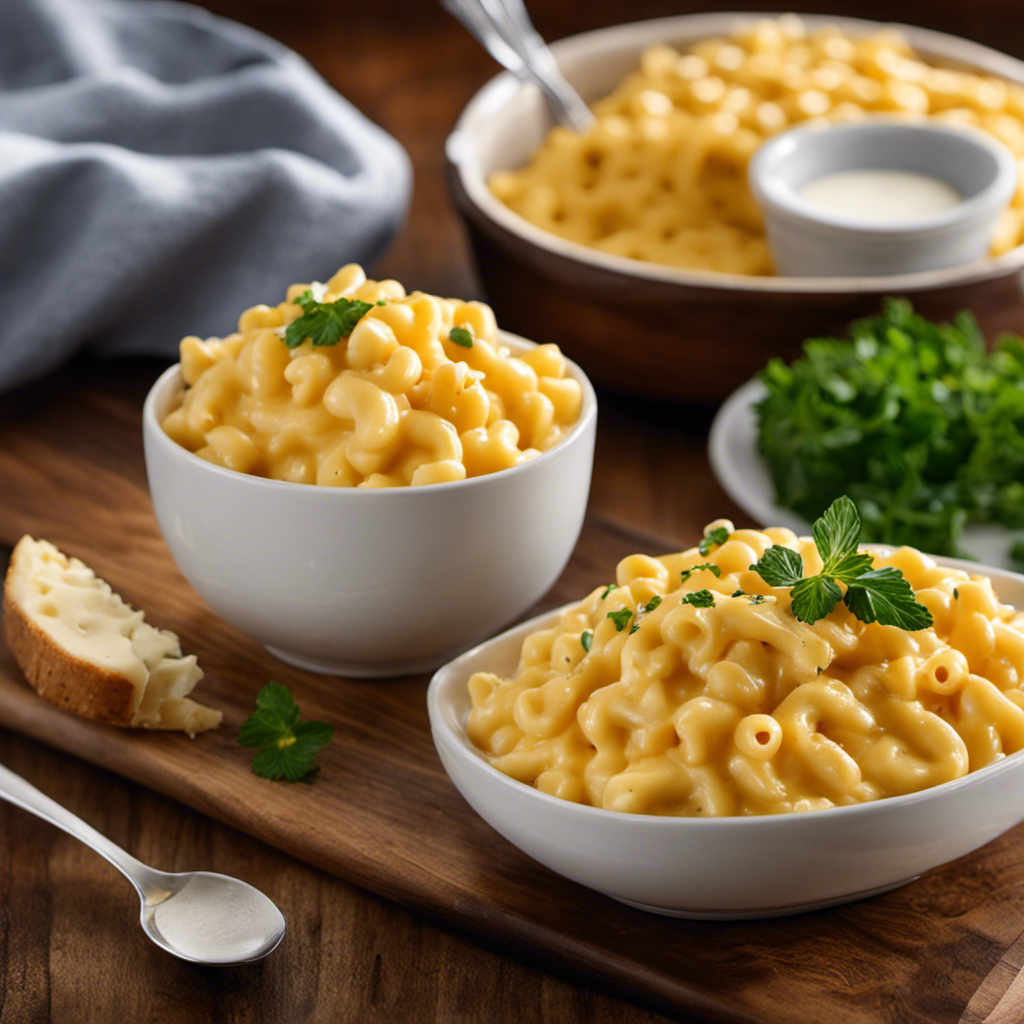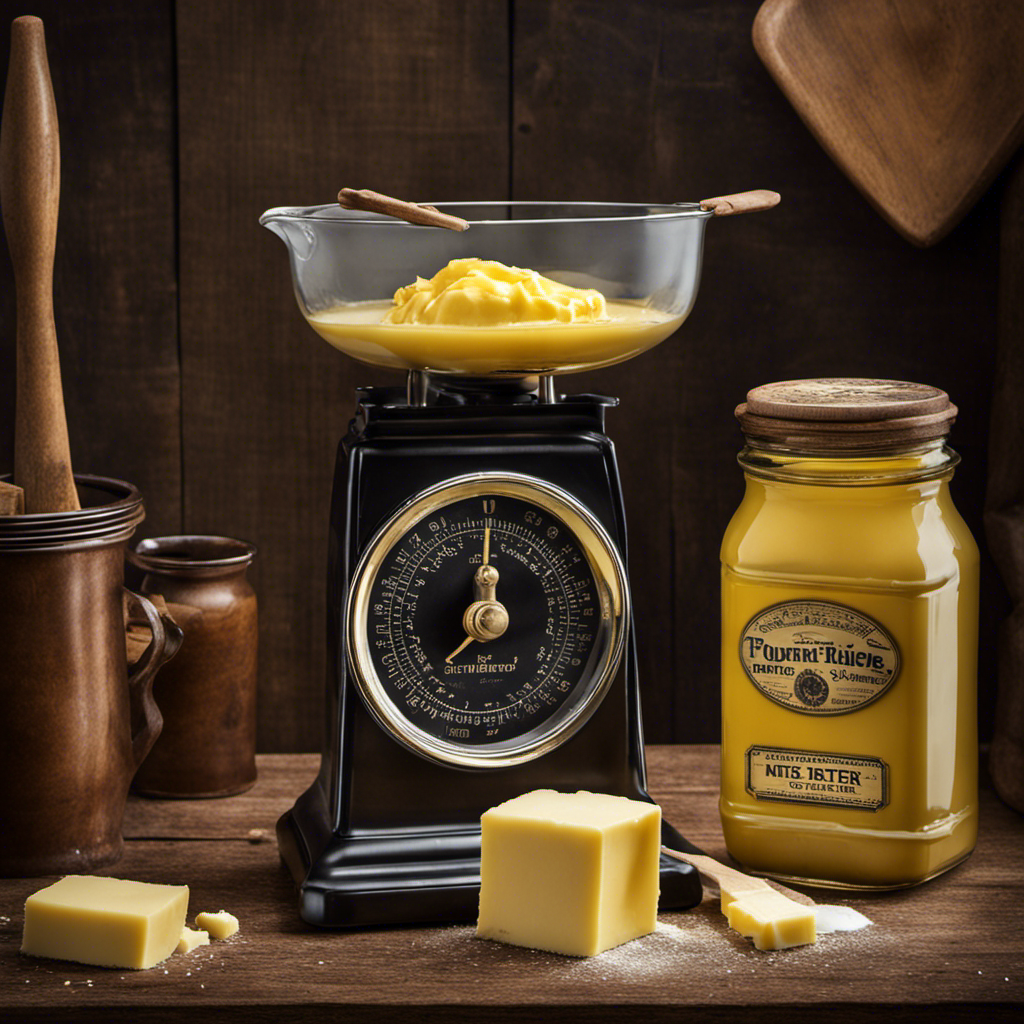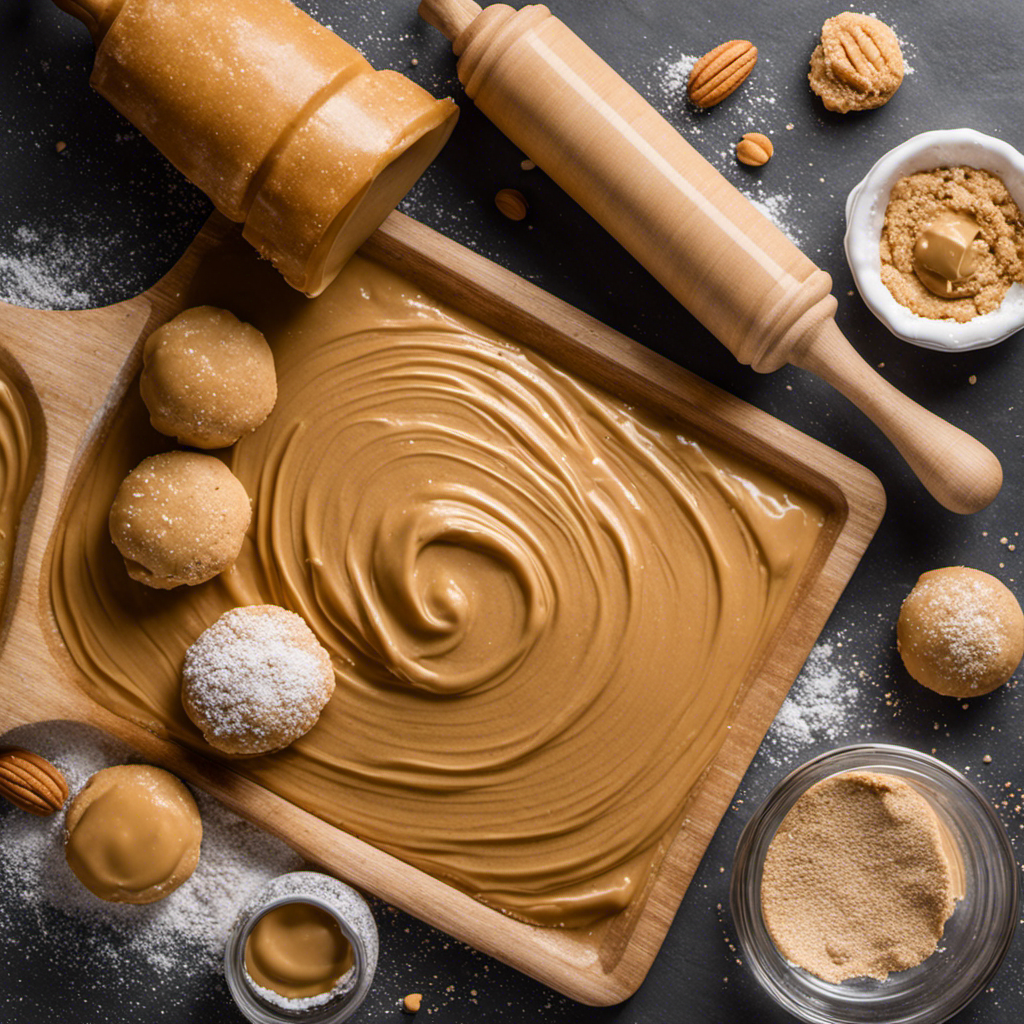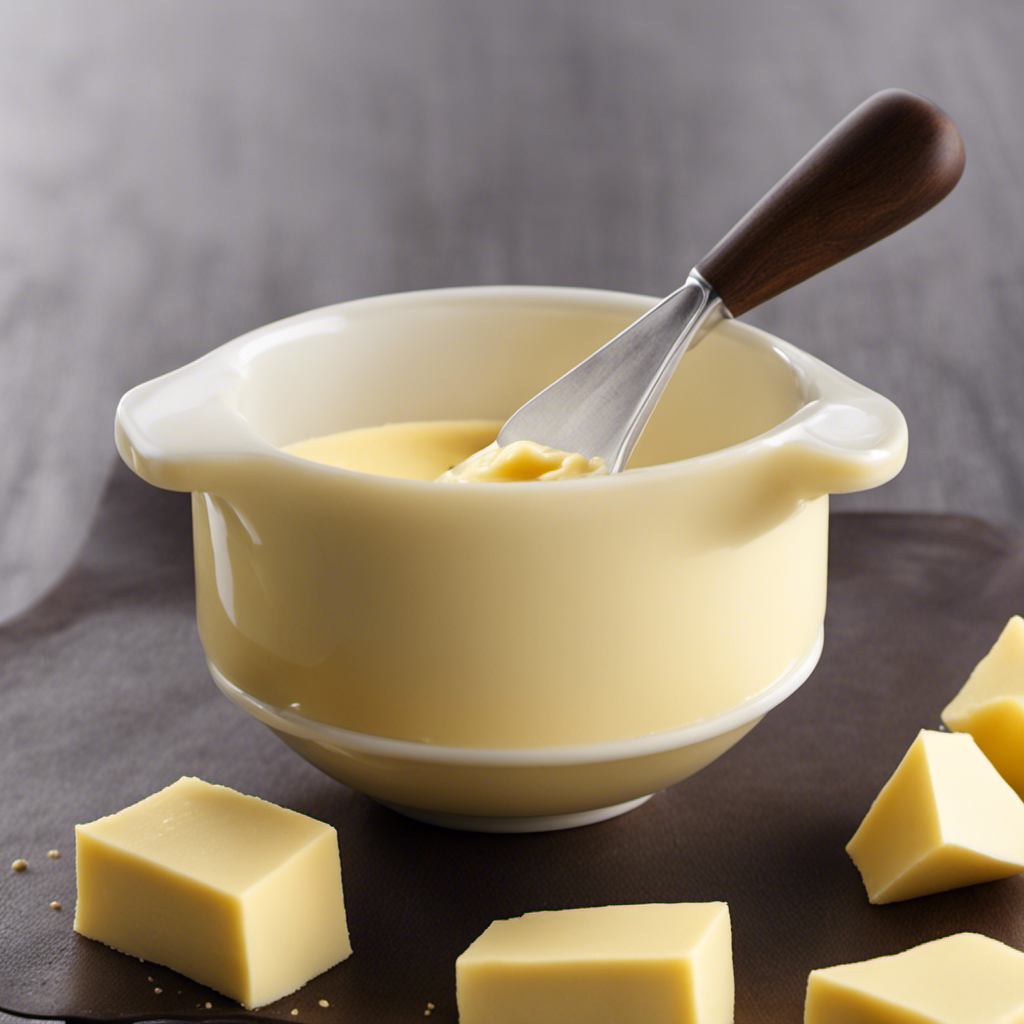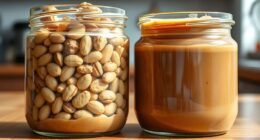As a fan of food and a devoted mac and cheese lover, I have always thought that butter is the perfect finishing touch to this rich dish.
However, what if I told you there are other equally delicious options to substitute for butter in your mac and cheese?
In this article, I will take you on a culinary journey filled with olive oil, coconut oil, avocado, and more.
Get ready to elevate your mac and cheese game with these delectable and healthier alternatives.
Key Takeaways
- Olive oil, coconut oil, and avocado are all substitutes for butter in mac and cheese, adding rich and creamy flavors to the dish.
- Greek yogurt, sour cream, and cream cheese can be used as substitutes for butter in mac and cheese, providing a tangy and creamy element to the dish.
- Vegetable broth and nutritional yeast can both be used as substitutes for butter in mac and cheese, adding rich and savory flavors to the dish while being low in calories and fat.
- Cheesy spreads and cashew cream are dairy-free options for substituting butter in mac and cheese, providing a creamy and flavorful alternative.
Olive Oil
If you’re out of butter, you can use olive oil as a substitute in your mac and cheese. Olive oil not only adds a rich flavor to your dish, but it also offers numerous health benefits.
Olive oil is high in monounsaturated fats, which can help reduce the risk of heart disease and improve cholesterol levels. Additionally, it contains antioxidants that can protect against inflammation and oxidative stress.
When using olive oil in your mac and cheese, it’s important to choose the right type. Extra virgin olive oil is the highest quality and has a strong, fruity flavor. Light olive oil, on the other hand, has a milder taste and is better suited for cooking at higher temperatures.
Now, let’s move on to another butter substitute – coconut oil.
Coconut Oil
To make your mac and cheese dairy-free, try using coconut oil as a substitute for butter. Coconut oil is a creamy alternative that not only adds a rich flavor to your dish, but also offers numerous health benefits. It is a great source of healthy fats, containing medium-chain triglycerides (MCTs) that can boost your metabolism and provide energy. Additionally, coconut oil is rich in antioxidants, which can help protect your cells from damage.
Here is a table highlighting some of the key health benefits of coconut oil:
| Health Benefit | Description |
|---|---|
| Boosts metabolism | Medium-chain triglycerides in coconut oil can increase energy expenditure. |
| Supports brain health | The MCTs in coconut oil can provide an alternative source of energy for the brain. |
| Improves heart health | Coconut oil contains lauric acid, which can increase good cholesterol levels. |
| Enhances digestion | The antimicrobial properties of coconut oil can help improve gut health. |
Avocado
Avocado is a versatile ingredient that can be used as a creamy and nutritious addition to many dishes. Known for its rich and buttery flavor, avocado can be a great substitute for butter in mac and cheese. Not only does it provide a creamy texture, but it also offers numerous health benefits.
Avocados are packed with heart-healthy monounsaturated fats, which can help lower bad cholesterol levels. They are also a good source of vitamins and minerals, including potassium, vitamin K, vitamin E, and vitamin C. Incorporating avocado into your mac and cheese not only adds a delicious creaminess but also boosts its nutritional value.
Now, let’s explore another alternative to butter in mac and cheese: Greek yogurt.
Greek Yogurt
Using Greek yogurt in your mac and cheese recipe will add a tangy and creamy element to the dish. Greek yogurt is a protein-packed alternative to butter that can give your mac and cheese a healthier twist. Here are three reasons why Greek yogurt is a great option:
-
Creaminess: Greek yogurt has a thick and creamy texture that can mimic the richness of butter, making your mac and cheese velvety smooth.
-
Tanginess: The tangy flavor of Greek yogurt adds a pleasant zing to the dish, balancing out the richness of the cheese.
-
Health benefits: Greek yogurt is a good source of protein, calcium, and probiotics, making your mac and cheese a more nutritious choice.
By using Greek yogurt, you can create a satisfying and flavorful mac and cheese that is both creamy and tangy.
Now, let’s explore another option: sour cream.
Sour Cream
Sour cream is a creamy and tangy alternative that can be used in a variety of dishes.
When it comes to mac and cheese, substituting butter with sour cream can enhance the flavor profile by adding a rich and velvety texture.
The tanginess of the sour cream also balances out the richness of the cheese, creating a deliciously balanced dish.
Creamy Tangy Alternative
If you’re looking for a creamy and tangy alternative to butter in mac and cheese, yogurt can be a great option. Not only does it provide a smooth and velvety texture, but it also adds a tangy flavor that complements the richness of the cheese.
Here are three reasons why yogurt is a fantastic choice:
-
Creamy Cashew: Yogurt made from cashews can mimic the creamy consistency of butter, making it a perfect substitute. It adds a luxurious mouthfeel to the dish, enhancing its overall indulgence.
-
Tangy Dairy-Free Option: For those who are lactose intolerant or follow a dairy-free diet, yogurt made from non-dairy milk like almond or coconut can offer the same tanginess without any dairy ingredients. It’s a great way to enjoy mac and cheese without sacrificing taste or dietary restrictions.
-
Healthier Choice: Yogurt is packed with beneficial probiotics, protein, and calcium, making it a healthier alternative to butter. It adds nutritional value to your mac and cheese, making it a guilt-free indulgence.
Enhances Flavor Profile
Now let’s delve into the health benefits of using alternative butter substitutes in mac and cheese, as well as some tips for achieving a creamy texture without using butter.
Making healthier choices doesn’t mean compromising on taste or texture.
When it comes to alternative butter substitutes in mac and cheese, options like olive oil, coconut oil, or avocado oil can provide a rich and flavorful base while offering numerous health benefits. These oils are packed with healthy fats and antioxidants, which can help improve heart health and reduce inflammation.
To achieve a creamy texture without butter, you can rely on ingredients like Greek yogurt or sour cream. These dairy products add a tangy and creamy element to your mac and cheese, enhancing the overall flavor profile. Additionally, using a combination of milk and cheese can also contribute to a velvety and smooth texture.
With these alternative butter substitutes and tips, you can create a delicious and healthier mac and cheese that doesn’t compromise on taste or texture.
Speaking of creamy alternatives, let’s now explore the world of cream cheese and its potential in mac and cheese recipes.
Cream Cheese
You can try using cream cheese as a substitute for butter in your mac and cheese recipe. Cream cheese adds a creamy, tangy flavor to the dish, enhancing its overall taste. Here are some reasons why cream cheese is a great alternative to butter:
-
Cream cheese vs sour cream:
-
Cream cheese has a thicker consistency, which helps create a creamier texture in mac and cheese.
-
Sour cream can add a tangy flavor, but it may also make the dish too runny.
-
Greek yogurt vs coconut oil:
-
Greek yogurt can be used as a healthier substitute for cream cheese, providing a creamy texture and tangy taste.
-
Coconut oil can add a subtle coconut flavor, but it may not provide the same creamy consistency as cream cheese.
Overall, cream cheese is a versatile ingredient that can enhance the flavor and texture of your mac and cheese. Give it a try and experience the delicious difference it can make!
Vegetable Broth
When using vegetable broth as a base for your recipe, it adds a rich and savory flavor that enhances the overall taste of your dish. Not only does vegetable broth provide a delicious taste, but it also offers several health benefits when used as a butter substitute in mac and cheese.
Vegetable broth is low in calories and fat, making it a healthier option for those watching their weight or trying to improve their overall health. Additionally, vegetable broth is packed with vitamins and minerals, such as vitamin C and potassium, which can boost your immune system and support proper functioning of your body.
To achieve a creamy texture with vegetable broth in mac and cheese, it is important to follow a few tips. First, use a high-quality vegetable broth that is rich and flavorful. This will ensure that your mac and cheese has a robust taste. Second, gradually add the vegetable broth to your mac and cheese mixture while stirring continuously. This will help to evenly distribute the broth and create a smooth and creamy consistency. Lastly, consider adding a small amount of cornstarch to thicken the sauce if needed.
In conclusion, using vegetable broth as a butter substitute in mac and cheese not only adds flavor but also provides health benefits. By following these tips, you can achieve a creamy texture that is sure to please your taste buds.
Now, let’s move on to the next section about nutritional yeast and its role in enhancing the cheesy flavor of mac and cheese.
Nutritional Yeast
When it comes to finding a cheesy flavor alternative and a nutrient-rich butter substitute, one ingredient that comes to mind is nutritional yeast.
This versatile ingredient not only adds a rich, cheesy taste to dishes like mac and cheese, but it is also packed with essential nutrients such as B vitamins, protein, and fiber.
Cheesy Flavor Alternative
One option for substituting butter in mac and cheese is using a cheesy spread instead. It’s a great alternative for those looking for dairy-free options or wanting to reduce their butter intake.
Here are some reasons why a cheesy spread can be an excellent choice:
-
Dairy-free options: Many cheesy spreads are made from plant-based ingredients, such as cashews, nutritional yeast, or tofu. This makes them suitable for people who are lactose intolerant or follow a vegan diet.
-
Melted cheese alternatives: Cheesy spreads have a creamy and gooey texture when heated, making them a perfect substitute for melted cheese. They add a rich and savory flavor to your mac and cheese without the need for butter.
-
Versatile flavors: Cheesy spreads come in various flavors, such as cheddar, mozzarella, or even spicy varieties. You can experiment with different flavors to find the one that suits your taste buds the best.
Using a cheesy spread as a substitute for butter in mac and cheese not only adds a delicious cheesy flavor but also provides dairy-free options and melted cheese alternatives.
Nutrient-Rich Butter Substitute
Using a nutrient-rich spread instead of butter adds a flavorful twist to your favorite mac and cheese recipe. When searching for healthy alternatives to butter in cooking, I discovered a variety of nutrient-rich spreads that are both delicious and good for you.
One option is olive oil, which is high in monounsaturated fats and adds a rich, buttery flavor to dishes. Another great choice is avocado, which is packed with healthy fats and provides a creamy texture to mac and cheese. If you’re looking for a dairy-free option, coconut oil is a fantastic substitute. It adds a subtle sweetness and pairs well with the cheesy flavors of the dish.
Cashew Cream
You can easily make a creamy and dairy-free mac and cheese by substituting cashew cream for butter. Cashew cream is a perfect creamy vegan option that adds richness and flavor to your dish without any dairy.
Here’s why cashew cream is a great dairy-free alternative:
-
Creaminess: Cashews have a naturally smooth and creamy texture when blended, making them an excellent base for a creamy sauce.
-
Nutritional Benefits: Cashews are packed with healthy fats, vitamins, and minerals, providing a nutrient-rich alternative to butter.
-
Versatility: Cashew cream can be customized with various spices and seasonings to create different flavors, allowing you to experiment and find your favorite combination.
Frequently Asked Questions
Can I Use Margarine Instead of Butter in Mac and Cheese?
I wouldn’t recommend using margarine as a substitute for butter in mac and cheese. Instead, try substituting olive oil or using ghee. They can provide a similar richness and flavor to your dish.
Is It Possible to Substitute Mayonnaise for Butter in Mac and Cheese?
Yes, it is possible to substitute mayonnaise for butter in mac and cheese. However, it will significantly change the taste and texture of the dish. Mayonnaise is creamier and tangier, so it may not be to everyone’s liking.
Can I Use Almond Milk as a Substitute for Butter in Mac and Cheese?
Yes, almond milk can be used as a substitute for butter in mac and cheese. Another option is to use soy milk. Additionally, coconut oil can be used instead of butter for a dairy-free alternative.
What Other Non-Dairy Options Can I Use Instead of Butter in Mac and Cheese?
There are several non-dairy alternatives that can be used instead of butter in mac and cheese. Some popular options include olive oil, coconut oil, and vegan margarine. These substitutes can enhance the flavor of your dish.
Can I Replace Butter With Vegetable Oil in Mac and Cheese?
Yes, you can replace butter with vegetable oil in mac and cheese. Another option is using coconut oil instead of butter. Both oils will provide a similar richness and creaminess to your dish.
Conclusion
After exploring various alternatives, it’s clear that there are plenty of options to substitute for butter in mac and cheese.
From the smooth and rich olive oil to the creamy and tangy Greek yogurt, each alternative brings its own unique flavor and texture to the dish.
Whether you choose the velvety avocado or the savory vegetable broth, your mac and cheese will still be a delectable treat.
So, don’t be afraid to experiment and let your taste buds embark on a tantalizing journey!
